
Beside the Old Church Gate Farm, Smarden, Kent

Coming Events — a hand holds out a knife to the back …
Dear friends and readers,
As for this brief survey of the life and art of Helen Allingham (she excelled in watercolor, oil, illustration, drawing) is (unlike the previous woman artists I’ve covered), I’ve too many pictures to share, I start with a characteristic one, women at work, where line and color and stance make for a sense of vital life; Coming Events, her alert capturing of everyday life; and Torcello, her paintings from Italy, unhappily not well-known. (If you click on some of the images, they enlarge beautifully. Just try.)
Helen Allingham may be distinguished from the seven women artists not because she made a lot of money or was successful (several of them were), but because of the seven I’ve covered thus far, Allingham is the only one not included in any of my basic surveys, though mentioned once by Germaine Greer as a type of “the wrong women singled out for praise” (p. 87) by her contemporaries and “the masculine establishment.” Not much by the latter as she’s singularly absent from most surveys (those dubbed general when they are mostly by and about men), except those specializing in Victorian/Edwardian genre (e.g., Christopher Wood). She is apparently sometimes likened to Fred Walker who painted and drew socially realistic pictures, but I suggest her vein is much richer, more varied, women-centered (a visual equivalent of l’écriture-femme).
Justice is done to Allingham by Deborah Cherry, in her full, informative, insightful Painting Women: Victorian Women Artists (8 straight pages and many single and double-page entries); a concise, reproduction-laden informative study by Ina Taylor, Helen Allingham’s England: An Idyllic View of Rural Life (Devon: Webb and Brower, 1990) more than compensates. The pictures are what matter.
There is only one known self-depiction (and I’ve not got a good copy, so Borzello ignoring Helen in her Seeing Ourselves has some justification), but she painted others:

Thomas Carlyle, a close friend to her husband
Tennyson:
and his favorite dog:
Then there are the riots of delicate watercolor:
She loved blue:
There is much that is not idyllic:

The Governess and the Ayah on the beach — most of Allingham’s women are embedded among children
Or with farm animals, domestic pets (here cats), standing among ruins or by buildings they never choose:

Another — we have the stains on the buildings, the fruits and vegetables real, how wretched she looks
She was a popular illustrator.

for her husband’s play, Ashby Manor (never produced)
and another of her brother, Henry Paterson, who died at 39 in an aslyum
Famously, she illustrated Hardy’s Far from the Madding Crowd (includes detailed discussions of some of the illustrations), and Hardy, then very unhappy with his wife, appears to have found in her a kindred soul. In 1874, He, she and Annie Thackeray dined together (1874) and he wrote this poem 40 years later on what he dreamed they might have known in marriage:
The Opportunity (For H.P)
Forty Springs back, I recall,
We met at this phase of the Maytime:
We might have clung close through all,
But we parted when died that daytime.We parted with smallest regret;
Perhaps should have cared but slightly,
Just then, if we never met:
Strange, strange that we lived so lightly!Had we mused a little space
At that critical date in the Maytime,
One life had been ours, one place,
Perhaps, till our long cold daytime.— This is a better thing For thee,
O man! what ails it?
The tide of chance may bring Its offer;
but nought avails it!
The line “strange, strange that we live so lightly” deeply suggestive about the nature of life
***********************

Helen Allingham, in her later years, widowed
There are many online biographies, from art galleries, to an official society website
What to say in brief? She was born into a comfortable middle-class family, her father a physician, and a mother with talent for art (shelved to provide a dowry for her husband to start his practice, to have 7 children), but part of the Unitarian dissenting world (so her father had hard times building a practice), with an aunt, Laura Hertford, a successful professional painter whom she emulated. Her father died relatively young (diphtheria , a harrowing time), and Helen experienced the necessity of making money. Her talent was cultivated: her Paterson aunts sent her to the Birmingham School of Design (studying drawing, painting, perspective, practical geometry, costume, and art-teaching).
By age 18 she is living in London, with a place at the Royal Female School of Art (learning anatomy), and supporting herself by jobs as an engraver, illustrator for Once a Week (among other magazines) where she learned to produce quickly:
A transformative event was her meeting with William Allingham (1874), originally from Ireland, had worked for Irish Customs and Excise for 20 years (he was 24 years older), wrote poetry and journalism, friends with Leigh Hunt, Tennyson, Browning, the Pre-Raphaelite brotherhood; he especially venerated Carlyle; they may have met at the theater and when he was hired as editor of Fraser’s (for 400£ a year), they married (1874). She worked at her career (remained convinced he had the superior talent, just not recognized), had children:
They went to Margate and Surrey for holidays, but when Carlyle died, they moved to Surrey for a country life, of work for her — she loved to go and paint the seaside:
1889 they lived in London some of the time, and had set up another home in Hampstead, with new and old friends (next to the Martineaus), more memberships in art societies, before he died in 1889. She was a widow for 37 years, filling her life with intense activity. She had to support her household, but she also returned to her husband’s home in Ireland (acting out what she conceived was her husband’s desire he never got to do) where she painted dozens of watercolors for once capturing the poverty and bleakness of what she saw in the houses themselves.
These years see her moving into more large landscapes
She traveled to Venice in 1901 and 1902 as part of attempts to break away from her usual subjects. Later in life she moved into landscape painting.

A study of Aire, St Maclou, in Rouen, done on the way to Venice — brilliance of line design, perspectives

A different color palette for Italy — gorgeous marble, cascading flowers, notice the woman and child with basketed flowers — are they transferring these to a husband/father to use with his customers or selling them or is that another woman selling flowers?
Hers was not a life of tragedy, but hard work, in a changing world; she was on the side of preservation, and there seems no doubt that her exclusion of the ubiquitious abysmal poverty and miseries of the era did not allow her work to be part of needed economic, social, political reform. She had a close friendship with Gertrude Jekyll (a career in photography, studying vernacular buildings and celebrating crafts), and Kate Greenaway, and after 1890 enabled one another (by going together) to paint more subjects, in more places, though her times painting alongside Greenaway didn’t last (their work was to unalike):
‘it was in the spring of 1888 that we went out painting together in the copses near Witley and became really friends …. One day in the autumn of 1889 [when they were neighbours in Hampstead] we went to Pinner [where from the cancelled manuscript of Persuasion we know Jane Austen meant Anne Elliot] together on an exploring expedition for subjects and were delighted with some of the old cottages we saw there. I had been pressing her ever since our spring time together at Witley to share with me some of the joys of painting out of doors. Another day we went farther afield – to Chesham and Amersham . . . . In the spring of 1890 I took my children to Freshwater, Isle of Wight and found ms for us near Kate. She and I went out painting together daily, either to some of the pretty old thatched cottages around Farringford or to the old dairy in the grounds …. During the summer of that year (1890) we continued our outdoor work together, generally taking an early train from Finchley Road to Pinner, for the day. She was always scrupulously thoughtful for the convenience and feelings of the owners of the farm or cottage we wished to paint, with the consequence that we were made welcome to sit in the garden or orchard where others were refused admittance.
Though we often sat side by side, painting the same object (generally silently – for she was a very earnest, hard worker – and perhaps I was, too), it seemed to me that there was little likeness between our drawings — specially after the completion in the studio. But she was one of the most sensitive of creatures and I think she felt it might be wiser for both of us to discontinue the practice of working from the same subjects …. (Cherry, p 177)
**********************
So what is this world of women in rural and eastern England:

An earlier picture: a version of her cradling her son, Henry

Women also hung out the wash in Verona
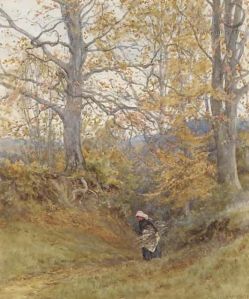
This is a woman gathering sticks and wood for the fire for winter

Valleywood Farm — lost in the middle distance
Buildings inside and out:

The Interior of Cheyne House (Carlyle’s)
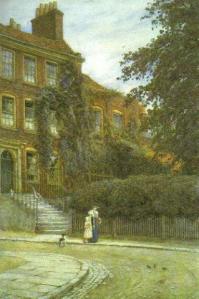
Stanfield House, Hampstead — stodgy and respectable

Aldworth — covered in flowery ivy, this mansion of the wealthy
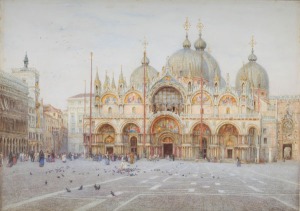
A fantasia of St Mark’s Cathedal, Venice, or as pastoral, Santa Maria:
More typically:

A big and old tree: Old Beech Tree
She loved gardening and has many still lifes of flowers and gardens, hills and meadows:

Blackdown, Sussex (I use this as my computer wallpaper)
**************************
Allingham’s best known book is The Cottage Homes of England; she saw herself as recording a vanishing way of life, and Christopher Wood suggests we should see her art as the visual equivalent of Flora Thompson’s Lark Rise to Candleford. Deborah Cherry argues that Helen Allingham’s pictures present female sexuality centrally in discreet (coded) ways, and were an influence for good from the respect they showed for women’s ordering, work, and past places and ties too.
I’ll end on a poem by Amy Clampitt, which while intended to characterize “George Eliot Country” and written for Eliot’s first magisterial biographer, Gordon Haight (1901-1985) seems to me to capture the same world as Allingham:
From this Midland scene – glum slagheaps,
barge canals, gray sheep, the vivid overlap
of wheatfield and mustard hillside like
out-of-season sunshine, the crabbed silhouette
of oak trees (each joint a knot, each knot
a principled demurral – tough, arthritic, stubborn
as the character of her own father) – fame,
the accretion of a Pyrrhic happiness, had
exiled her to London, with its carriages
and calling cards, its screaming headaches.Griff House – dear old Griff, she wistfuly
apostrophized it – in those days still intact,
its secrets kept, has now been grafted to a
motel-cum-parking-lot beside the trunk road,
whose raw, ungainly seam of noise cuts through
the rainy solace of Griff Lane: birdsong,
coal smoke, the silvered powderings of
blackthorn, a flowering cherry tree’s
chaste flare; the sludge-born, apoplectic
screech of jet aircraft tilting overhead.The unmapped sources that still fed nostalgia
for a rural childhood survive the witherings
of retrospect: the look of brickyards,
stench of silk mills, scar of coal mines,the knife of class distinction: wall-enclosed,
parkland-embosomed, green-lawned Arbury Hall,
fan-vaulting’s stately fakeries, the jewel-
stomachered, authentic shock of Mary Fitton and
her ilk portrayed, the view of fishponds – school
and role model of landed-proprietary England.Born in the year of Peterloo, George Eliot
had no illusions as to the expense of such
emoluments. Good society (she wrote) floated
on gossamer wings of light irony, required no less
than an entire, arduous national existence,
condensed into unfragrant, deafening factories,
cramped into mines, sweating at furnaces, or
scattered in lonely houses on the clayey or chalky
cornland… where Maggie Tulliver, despairing
of gentility, ran off to join the gypsies.Violets still bloom beside the square-towered
parish church where Mary Anne was christened;
the gnashed nave of Coventry fills up with rain
(another howling doodlebug of fright hurls itself
over); the church from which, refusing to commit
the fiction of a lost belief in One True Body,
she stayed away, upholds the fabric in which her
fictions, perdurable now, cohere like fact: Lydgate
still broods, Grandcourt still threatens, and
in Mrs Transome disappointment turns to stone.
One last connection, back to Charlotte Smith with Near Beachy Head:
Allingham’s is a world of women at work, women surrounded by children, and their work. She seeks them out, she records them and celebrates their creations, adds to these:

A Side Canal in Venice (notice the woman high up behind the arch banging out the wet or dirt from a pink cloth of some type
Ellen













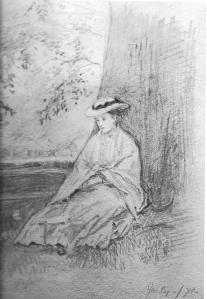






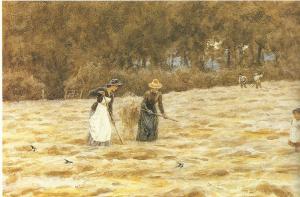







Thus far:
Caterina Van Hemmesen (1527/8-1581)
Artemisia Gentileschi (1593-1652)
Rosalba Carriera (1675-1757)
Francois Duparc (1726-1778)
Anne Vallayer-Coster (1744-1818)
Paula Modersohn-Becker (1876-1909)
E.M.
I am delighted to see Ellen Moody’s blog post about Helen Allingham
Those interested in the artist will like to know that the Grolier Club recently published the catalogue by Natasha Moore for an exhibition of William and Helen Allingham which took place earlier this year:
Natasha Moore
Victorian Connections: The Literary and Artistic Circles of William and Helen Allingham from the Collections of Grolier Club Members
New York: Grolier Club, 2015
ISBN: 9781605830599
This exhibition catalogue, drawn entirely from the collections of Grolier Club members, is devoted to Anglo-Irish poet, diarist, and editor William Allingham (1824-1889) and his wife Helen (1848-1926), one of the most successful women artists of the time.
It features their own work (some of it collaborative) and extends to represent, through association copies, manuscripts, and portraits, the Allinghams’ circles of friends and associates. Highlights include William Allingham’s commonplace book (containing a transcription of the first letter from D. G. Rossetti to Robert Browning) and his copies of Shelley and Whitman; the baby book for the Allinghams’ son, Gerald, with unpublished on-the-spot accounts of Tennyson, Carlyle, and George Eliot; Mark Twain’s annotated copy of William Allingham’s 1907 Diary; D. G. Rossetti’s original design for Allingham’s Day and Night Songs; watercolors and a sketchbook by Helen Allingham; rare photographs by Julia Margaret Cameron and Lewis Carroll; and drawings by Kate Greenaway, Edward Burne-Jones, and John Butler Yeats.
-Copies may be purchased from the club’s distributor, Oak Knoll Books, in New Castle, DE.
http://www.oakknoll.com
Full disclosure: I lent items to the exhibition and designed the catalogue.
Mark Samuels Lasner
Senior Research Fellow
University of Delaware Library
Hundreds of people coming over. From Elizabeth Dwiar on twitter: Fascinating blog- there’s more to #HelenAllingham than I realised @Amanda_Vickery -Hardy, Tennyson, Carlyle, Pre-Raphaelites!
Dear Ellen Moody,
I know of you from the Victoria Listserv and have always been grateful for your work. I’m inspired to email my thanks by your post of August 20, with links to your reveries blog and its presentation of women artists. What a lovely blog, and so informative. I teach the Pre-Raphaelites as a literature professor, and I always focus on gender. The women artists you feature really introduced me to new possibilities, as well as new delights, and I’m very grateful!
Best, Becky King
Middle Tennessee State University
Murfreesboro, TN
a really interesting ,well researched article,Thank you.
In Ballyshannon, Donegal,Ireland there is each year an Allingham Arts Festival in November.I am currently researching Helen Allinghams role as a conservationist in her recording of cottage gardens and her nature paintings in order to do a workshop at this years festival titled ‘From Chelsea to Ballyshannon.Together with horticulturist Brendan Little, I will focus on the relevance of her Art to the current popularity of rewilding and naturalistic planting in garden design.
I am having difficulty in sourcing images of Helen Allinghams paintings of Irish scenes.I have a beautiful 1904 copy of the Marcus B.Huish book on her work but he only includes two as the book tittle is Happy England.If anyone knows where I can source them online I would be very grateful.
olivetravers1@eircom.net.
Thank you.
And thank you for this praise. You led me to re-read what I wrote, re-look at the images and fall in love with these paintings all over again. I come on also to say the book I made central use of is Ina Taylor’s Helen Allingham’s England: An Idyllic View of Rural Life. I know I read a couple of articles on her art, and looked at a group of surveys which also included sections on her work. I am glad to see how her reputation is improving and she is gaining the respect she should have had much earlier.
Many thanks for that information Ellen and well done on your educational blog.I will get the book you recommend and do believe that exploration of different aspects of Helen Allinghams art will be of great interest here in Donegal at the annual Allingham Arts Festival.
good wishes
Olive
Unless I read it wrong, the comment under the painting ‘Coming Event’ says the hand is holding a knife. Surely it’s a saucer of milk for the cat?
Thanks for an interesting article.
Thank you for the correction. I’ll check.